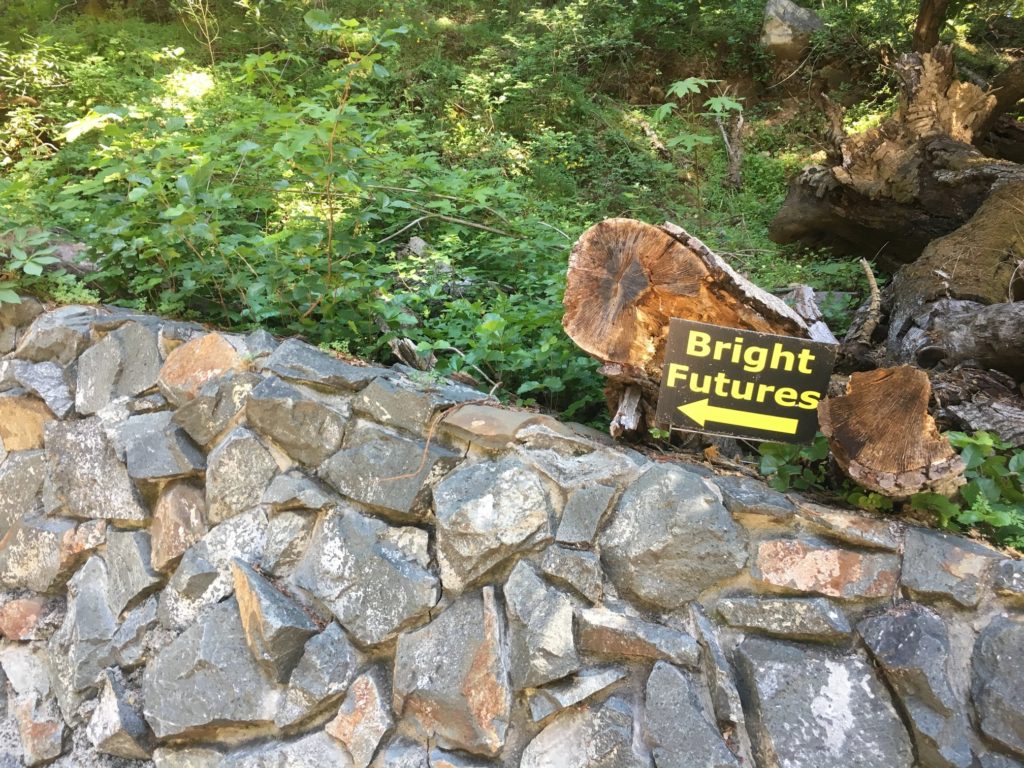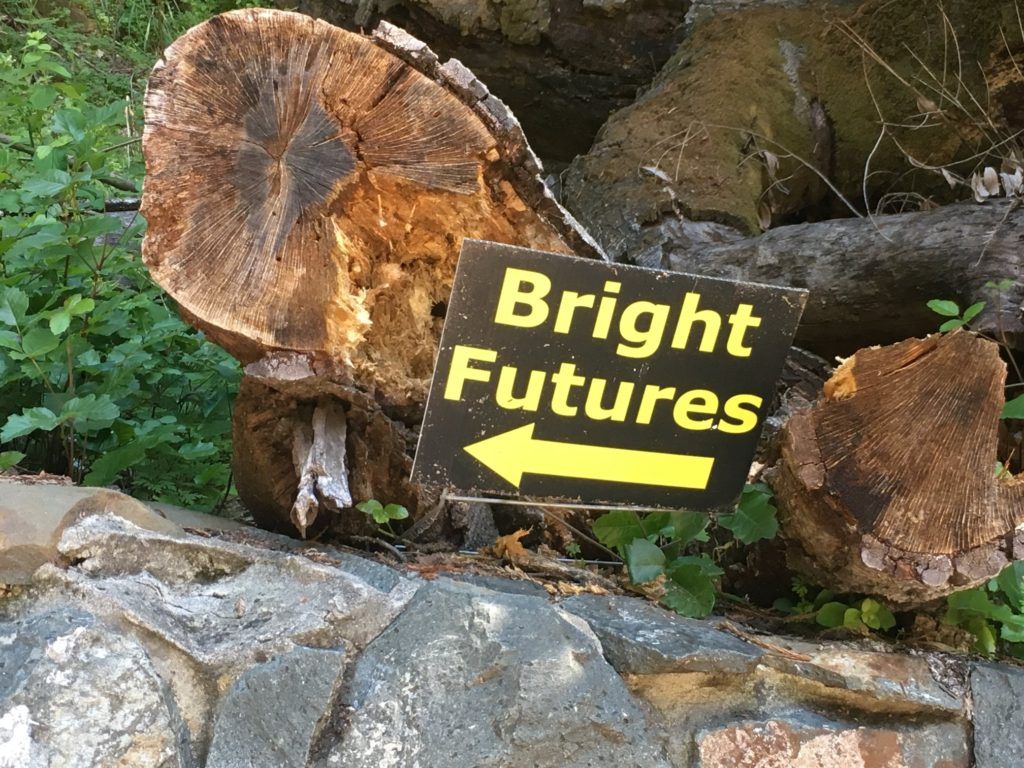On Tuesday, April 14 I went on a hike, checked on my “Bright Futures” sign and got disturbed by what I saw. (For context, see my recent post on April 4 about this “sign of mass awakening,” here.)
What disturbed me is that a massive chunk of the log broke away and slightly tilted the “Bright Futures” sign downward, making it not as visible to passers-by. Not at all happy about that, I took my fingers and flicked the piece of log away, and the sign bounced back up. Then I continued my walk.
At first I didn’t know what to make of this, but then the next morning I awakened with the message. I knew I had to go photograph the log, and went on my walk early that day. Here’s the photo below.

As you can see, a huge chunk of the dead log broke away. This dead log, that was preventing the people from seeing Bright Futures, had broken away. And all you have to do now is just flick it all away. Like you’d flick an ant off your lunch plate.
I took a closeup. See below.

(No, I did not have anything to do with physically breaking the log.)
This reminds me, though, of an incident back in 1988, when I was on a trip in Turkey with my then-boyfriend, W., and my sister, L. The following is an excerpt taken from my first book, What Everyone Believed: A memoir of intuition and awakening, describing that incident. (I later created a Kindle verson under the title, Reconnected: A spiritual awakening memoir.)
“W. was extra irritated with me … because I had accidentally bent the passenger side headrest of his beloved VW bug—the pair of stainless-steel prongs that attach the headrest to the seat back. We had been sightseeing in the interior of the country, admiring limestone terraces that reminded me of frozen, cascading waterfalls, like the Minerva Terraces at Yellowstone National Park, except in Turkey the tourists were, oddly enough, allowed to trample all around those magnificent natural formations. I had innocently gone back to the car to get my camera. Leaning my left arm on the passenger-side headrest, I reached over to the back seat where my Nikon lay and before I knew it, I bent the steel back, as if by magic. Strange, too, was that I heard it kind of click into place at an angle of about forty-five degrees. I tried to bend it back but it wouldn’t bend. This incident startled me; it was something I would call a phenomenon.
I caught up with L. and W. at the terraces and informed him that something was wrong with the headrest of his car. The three of us rushed back to have a look and indeed, it was still bent.
But it was W.’s reaction that surprised me the most: Instead of being interested by the odd unexpectedness of this and perhaps curious as to the cause—maybe a flaw of some sort, and the best I could do at the spur of the moment—he got angry with me. He started yelling and screaming, “Why did you do that? You put your whole weight on it, didn’t you?” and we weren’t even married yet.
“I didn’t do anything, something must be wrong with it,” I tried to explain. But he dismissed my explanation.
I protested: “I weigh a hundred and twenty-five pounds, and even if I did put my whole weight on it, which would have been a pretty sight and which anyway I most certainly did not, I shouldn’t have bent that stupid thing!”
Were the properties of stainless steel so variable, so unreliable that if you were to lean on a structural element of an automobile, it might collapse? I was a materials scientist after all, on staff at the Department of Experimental Physics of a prestigious German university. I mingled with Nobel laureates in physics at staff barbeques, and I didn’t have a rational explanation. Yet he had the nerve to pin the blame on me, as if I had done this on purpose just to spite him.
W. tried to bend the prongs back, but they wouldn’t bend. Then he lifted the whole contraption out and tried to bend it against the ground, but it wouldn’t budge. So we took it to an auto-repair shop, where the three of us stood around waiting for it like strangers at a train station. I saw a mechanic put it into a vise, but it wasn’t easy to bend. I noticed I actually felt guilty about it, as if I were a child who had done something wrong. They might have wondered how it got bent—a bad car accident, maybe. Maybe they viewed it as some sort of practical joke. There must be practical jokes in Turkey, I would think. Well, I am just babbling on self-importantly here because I’m not so sure they wondered about it at all. They didn’t ask any questions, and we didn’t volunteer any information; they just continued fixing it as if a bent headrest was completely normal. And now that I think about it, perhaps calling my experience a phenomenon or a wonder is a bit grandiose for what could, after all, have been a common occurrence in Turkey.
In any case, after it was fixed W. and I didn’t discuss this incident further and nothing of this sort ever happened again. Maybe we figured that if we had actually discussed this, it might have come to seem real, so we avoided the topic altogether. Years later I discovered a possible clue about the area in Turkey where the stainless-steel supports got bent—the veils between dimensions are supposedly thin there. I read this once in some book, but I’m not sure it explains anything. However, perhaps one reason why the European Union is reluctant to admit Turkey is that the basic natural laws of this dimension can’t always be counted on over there. But maybe our laws of physics are currently incomplete?”
So what do I make of all this? In a nutshell, I believe that things are finally falling into place. The work that we’ve been doing for decades is finally coming to fruition. Humanity is awakening en masse. Bright Futures are manifesting. And all you have to do right now is flick away the “dead wood.”
Share this